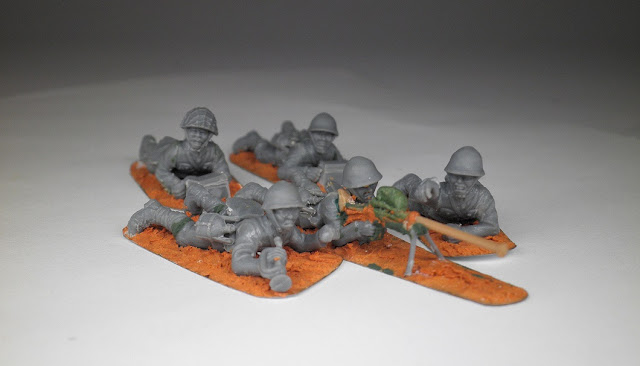In this post I have included a step by step tutorial for making clothes lines and hay stacks.
 |
| BEF troops rushing thru a French yard with the forgotten washing still on the line. |
 |
| Here is how I made them, first step is to use 3mm MDF for the base. |
 |
| Cut out 3 bases 9cm long and 2 cm wide. |
 |
| Chamfer the edges with a wood file. |
 |
| Prepared 6 matches 5cm long for the posts. |
 |
| Scribed the matches to create wood grains with the edge of a hobby knife. |
 |
| Drilled 2 holes matching the diameter of the matches. |
 |
| Superglued them into position. |
 |
| I raided my wife's sewing box for some thick thread and used the BEF trooper to gauge the correct height for the clothes line. . |
 |
| Tied both ends. |
 |
| I applied superglue to the knots and the on the matches to strengthen them. |
 |
| Next step, raid my wife's sewing box again for a suitable thread and needle and scavenge some bits of cloth. |
 |
| I used scissors to cut out shapes of towels and clothing. |
 |
| I used the needle with the thread to sew the cloth onto the line. |
 |
| Close up image |
 |
| Used scissors to cut the red thread but not too close to allow for a bit of thread to stick up as this will mimic the pegs. |
 |
| Drop some superglue to secure it in place and continue with the rest of the pegs this will help them stand straight up. |
 |
| Completed clothes line, leave to dry and then proceed to undercoat them and stat the painting process. |
 |
| I forgot to include images of the clothing baskets I made from Milliput each clothes line has its own distinct basket. |
 |
| Side view showing how the clothes are responding to the wind. |
 |
| This must be a strong gust of wind as its also toppled over the clothes basket. |
 |
| I used Vallejo Model colour paints. |
HAY STACKS
 |
| I made 6 Hay stacks from Rubberized Horse hair. |
 |
| BEF troops making there way to the edge of the wheat field. |
 |
| First step is get hold of some Rubberized Horse hair and cut 6 cubes. |
 |
| Tease out the fibers with a pair of scissors. |
 |
| Image showing the teasing out of the fibers. |
 |
| View of the base trimmed to create a circular base. |
 |
| Carefully remove fibers from the top portion of the stack to create a tapper. |
 |
| Use scissors to help with this process. |
 |
| It should look something like this. |
 |
| Hay stack ready for the next step. |
 |
| Prep some toothpicks by creating texture in the top portion of the toothpick. |
 |
| Paint them. |
 |
| Insert the toothpick and secure in place with some glue from a hot glue gun. |
 |
| BEF trooper next to the Hay stack. |
 |
| A gaming table with 3 Hay stacks located in the recently harvested wheat fields. |
Cheers John




























